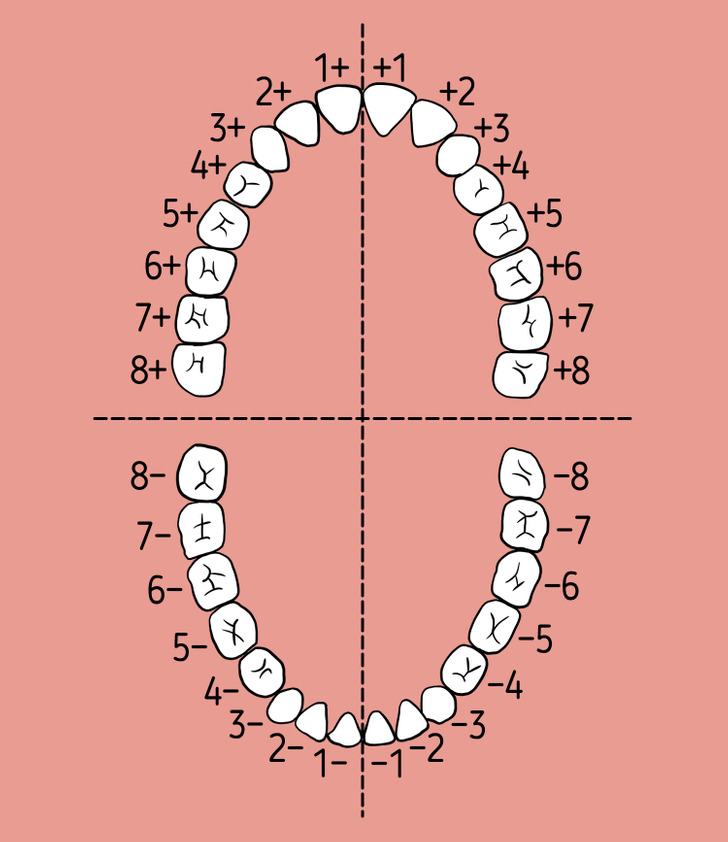If you are new to Canada, or if you are just visiting, you may be wondering about their teeth numbering system. Teeth are numbered differently in Canada than they are in the United States. In this article, we will discuss the teeth numbering chart in Canada, and provide some tips on how to remember it!
Teeth Numbers Canada: The Quadrant System
In Canada, the FDI World Dental Federation notation is used for numbering teeth. Each tooth is given two numbers to represent its location. The first number is the quadrant in which the tooth is located, and the second number represents the tooth’s position within that quadrant.
This means that each quadrant (upper left, upper right, lower left, lower right) is numbered separately. The teeth in each quadrant are then numbered from front to back, starting with the tooth closest to the midline of your face.
Teeth Quadrants
Teeth quadrants are given their names from the patient’s perspective. This means that each quadrant is given its name based on its location in relation to the patient’s view of themselves.
In adult teeth, the teeth quadrants are numbered as follows:
- Upper right quadrant (UR): Quadrant 1
- Upper left quadrant (UL): Quadrant 2
- Lower left quadrant (LL): Quadrant 3
- Lower right quadrant (LR): Quadrant 4
In baby teeth, also known as primary teeth, the teeth quadrants are numbered differently. The teeth in the primary dentition are:
- Upper right quadrant (UR): Quadrant 5
- Upper left quadrant (UL): Quadrant 6
- Lower left quadrant (LL): Quadrant 7
- Lower right quadrant (LR): Quadrant 8
Teeth Numbering

The teeth in each quadrant are then numbered from #1-8. The tooth numbers start at the center of the mouth and move towards the back.
Each number corresponds to a different type of tooth in the adult human body:
- Tooth 1: Central Incisors
- Tooth 2: Lateral Incisors
- Tooth 3: Canine (Cuspids)
- Tooth 4: First Premolar (First Bicuspid)
- Tooth 5: Second Premolar (Second Bicuspid)
- Tooth 6: First Molar
- Tooth 7: Second Molar
- Tooth 8: Third Molar (Wisdom Tooth)
In children’s teeth each number corresponds to the following:
- Tooth 1: Central Incisors
- Tooth 2: Lateral Incisors
- Tooth 3: Canine (Cuspids)
- Tooth 4: First Molar
- Tooth 5: Second Molar
Teeth Numbers Canada: Putting it All Together

Now that we’ve gone over the basics of teeth numbering in Canada, let’s put it all together.
Remember, the first number will always correspond to the quadrant in which the tooth is located. The second number will correspond to the type of tooth it is.
For example, tooth 46 is the first molar, located in the bottom right corner of your own mouth. From the dentists’ perspective, it would be located in the lower left quadrant.
How does the American Teeth Number System Compare to Teeth Numbers in Canada?

In the United States, teeth are numbered using a different system without quadrants, called the universal number system. In this case, each tooth is given a unique number from #1-32.
Here, the back right third molar (wisdom tooth) is given #1. Teeth are then numbered consecutively from #1-32 as you continue clockwise around the mouth.
Despite its name, the “universal numbering system” is mostly only used in the United States and Mexico. The FDI World Dental Federation notation is the internationally accepted teeth numbering system used by most countries. There is one other exception, the United Kingdom, which sometimes uses the more outdated palmer system of numbering teeth.
While the Canadian teeth numbering system may seem confusing at first, it’s actually quite simple once you get the hang of it. Just remember that each quadrant is numbered separately and that the teeth within each quadrant are numbered from front to back. With a little practice, you’ll be able to number teeth like a pro in no time!
Disclaimer
The contents of this website, such as text, graphics, images, and other material are for informational purposes only and are not intended to be substituted for professional medical advice, diagnosis, or treatment. Nothing on this website constitutes the practice of medicine, law or any other regulated profession.
No two mouths are the same, and each oral situation is unique. As such, it isn’t possible to give comprehensive advice or diagnose oral conditions based on articles alone. The best way to ensure you’re getting the best dental care possible is to visit a dentist in person for an examination and consultation.
SAVE TIME AND MONEY AT ANY DENTIST

Less dental work is healthier for you. Learn what you can do to minimize the cost of dental procedures and avoid the dentist altogether!


Hello I have a question please email me how many roots does tooth number 46 should have Tony
That information is all located in this article https://webdmd.org/molars/